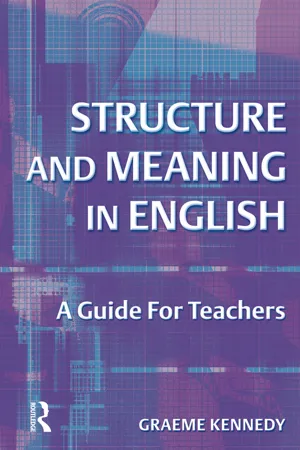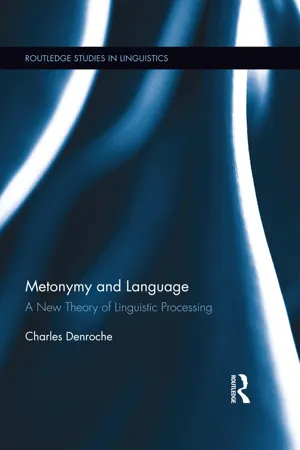Languages & Linguistics
Hyponymy
Hyponymy is a linguistic relationship where the meaning of a more specific word (hyponym) is included in the meaning of a more general word (hypernym). For example, "rose" is a hyponym of "flower." This concept is important in understanding the hierarchical structure of language and how words relate to each other in terms of specificity and generality.
Written by Perlego with AI-assistance
Related key terms
3 Key excerpts on "Hyponymy"
- eBook - ePub
Structure and Meaning in English
A Guide for Teachers
- Graeme Kennedy(Author)
- 2014(Publication Date)
- Routledge(Publisher)
drag. Translation between languages assumes that loose synonymy between word forms is possible.The use of synonyms is important for avoiding repetition, and thus contributes to cohesion in texts, e.g.We rang for a taxi at 9 p.m. but the cab didn’t come till after 10.2.2.11 AntonymySemantic relationships can also exist between pairs of words which have opposite meanings. These are called antonyms, e.g.wetdrylateon timesamedifferentmorelesskindunkinddirectindirectAntonyms that are generated by prefixes such as un-, in-, im-, il-, ir- are a rich source of vocabulary in English.2.2.12 HyponymyMany words can be described as being semantically subordinate or superordinate to other words. Thus, dog is subordinate to mammal, which in turn is subordinate to animal, which in turn is subordinate to creature. A word that is subordinate to another in this way is called a hyponym. On the other hand, dog is also superordinate to words such as terrier or spaniel, etc. Apple is a hyponym of fruit which in turn is a hyponym of food, and so on. Language learners can get good value from learning superordinate words. The words thing and stuff, for example, are extremely useful because most common nouns are hyponyms of them.2.3 Categories of meaningThe many kinds of semantic relationships associated with individual words mentioned briefly in 2.2.1 to 2.2.12 are part of even wider networks of meaning. Linguists sometimes distinguish between the propositional meaning (or ‘sense’) of whole utterances and their illocutionary meaning (or ‘force’). When someone says It’s been a hot day a listener might respond by saying Would you like a beer? Literally interpreted, the utterance It’s been a hot day has the ‘sense’ of being about the weather. The response Would you like a beer? suggests that the listener interprets the original statement as having the illocutionary force of being a request. On the other hand, It’s been a hot day might have a completely different semantic function, as ‘small talk’ perhaps to open or keep open channels of communication – this is its phatic function. Such ‘small talk’, including comments on the weather, families, food, recreation, greetings and so on, enables us to make contact with the people we meet and opens up the discourse for further communication. Illocutionary meaning and other functions of speech are discussed in more detail in Chapter 8 - eBook - ePub
Metonymy and Language
A New Theory of Linguistic Processing
- Charles Denroche(Author)
- 2014(Publication Date)
- Routledge(Publisher)
The text builds up in the reader’s mind a specific image of the protagonist, Thoreau, the axe he borrows, the wood he walks towards and the pond he sees. It is a specific set of mutually coherent images, which still leaves scope for further narrowing as the prose progresses. The words on the page give access to the general sense associated with those words and ‘metonymic processing’ narrows them down to the specific image that the reader constructs for that particular reading.Defining Categories
Because the relationship between superordinates (general categories) and hyponyms (sub-categories) involves part-whole relations, metonymy is very well suited to identifying general categories which do not have convenient labels. Departments within retail stores and sections of supermarkets, for example, can be identified in this way. In data from my notebooks, I noted that in a branch of the UK supermarket Tesco , the section for pharmacy products was identified metonymically by ‘Aches and Pains’ (metonymic because products for treating ailments other than pain and products of general hygiene are found there), alongside sections identified using literal superordinates, such as ‘Canned Goods’, ‘Household Goods’ and ‘Soups’. In another UK supermarket, Morrisons , the term ‘Medicines’ was used for this section. In both cases, the term ‘Pharmacy’ was perhaps not used because it was considered to sound too medical or it suggested that a trained pharmacist was on hand, though it is the term used by another UK supermarket chain, Waitrose .Many languages have a single word standing for both superordinate and hyponym, eg in the Native American Indian language Hopi, the word for ‘cottonwood’ means both ‘deciduous tree’ and ‘cottonwood tree’ (the most common deciduous tree in this region); and in the Native American Indian language Shoshoni, the word for eagle means both ‘eagle’ and ‘large bird’ (Glucksberg 2001:39). The relationship between these words is metonymic. In sign languages, salient features are used to identify celebrities, such as ‘big ears’ for Prince Charles and ‘opening a trouser zip’ for Bill Clinton. In American Sign Language, many super-ordinate categories do not have their own sign, so, for example, ‘furniture’ is achieved by ‘chair-table-bed etc’ (signed rapidly with the sign for ‘etc’ “crisply executed”), thus, to express “I lost my furniture in the house fire, but one thing was left, the bed - eBook - ePub
Natural Language Processing and Computational Linguistics 2
Semantics, Discourse and Applications
- Mohamed Zakaria Kurdi(Author)
- 2017(Publication Date)
- Wiley-ISTE(Publisher)
lie in). In addition to rare cases of total homonymy, two forms of partial homonymy can be distinguished: homophony and homography.Homophony is the relation that is established between two words that have different meanings but an identical pronunciation. Homophones can be in the same grammatical category, such as the nouns air and heir that are pronounced [er], or from different categories, like the verb flew and the nouns flue or flu that are pronounced [flü].Homography is the relationship between two semantically, and some syntactically, different words that have an identical spelling. For example, bass [beɪs ] as in: Bass is the lowest part of the musical range, and bass [bas] as in: Bass is bony fish are two homographs. Note that when homonymy extends beyond the word as in: she cannot bear children, this is often referred to by the term ambiguity.Polysemy designates the property of a lexical item having multiple meanings. For example, the word glass has, among others, the following meanings: vitreous material, liquid or drink contained in a glass, a vessel to drink from and lenses. Once in a specific context, polysemy tends to disappear or at least to be reduced, as in these sentences [1.3] :John wants to drink a glass of water. [1.3]John bought new glasses. Mary offered a crystal glass to her best friend.It should also be noted that polysemy sometimes entails a change in the syntactic behavior of a word. To illustrate this difference, consider the different uses of the word mouton (sheep in French) presented in Table 1.4
Index pages curate the most relevant extracts from our library of academic textbooks. They’ve been created using an in-house natural language model (NLM), each adding context and meaning to key research topics.


